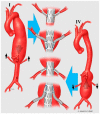Peri-Operative Management of Patients Undergoing Fenestrated-Branched Endovascular Repair for Juxtarenal, Pararenal and Thoracoabdominal Aortic Aneurysms: Preventing, Recognizing and Treating Complications to Improve Clinical Outcomes
- PMID: 35887518
- PMCID: PMC9317732
- DOI: 10.3390/jpm12071018
Peri-Operative Management of Patients Undergoing Fenestrated-Branched Endovascular Repair for Juxtarenal, Pararenal and Thoracoabdominal Aortic Aneurysms: Preventing, Recognizing and Treating Complications to Improve Clinical Outcomes
Abstract
The advent and refinement of complex endovascular techniques in the last two decades has revolutionized the field of vascular surgery. This has allowed an effective minimally invasive treatment of extensive disease involving the pararenal and the thoracoabdominal aorta. Fenestrated-branched EVAR (F/BEVAR) now represents a feasible technical solution to address these complex diseases, moving the proximal sealing zone above the renal-visceral vessels take-off and preserving their patency. The aim of this paper was to provide a narrative review on the peri-operative management of patients undergoing F/BEVAR procedures for juxtarenal abdominal aortic aneurysm (JAAA), pararenal abdominal aortic aneurysm (PRAA) or thoracoabdominal aortic aneurism (TAAA). It will focus on how to prevent, diagnose, and manage the complications ensuing from these complex interventions, in order to improve clinical outcomes. Indeed, F/BEVAR remains a technically, physiologically, and mentally demanding procedure. Intraoperative adverse events often require prolonged or additional procedures and complications may significantly impact a patient's quality of life, health status, and overall cost of care. The presence of standardized preoperative, perioperative, and postoperative pathways of care, together with surgeons and teams with significant experience in aortic surgery, should be considered as crucial points to improve clinical outcomes. Aggressive prevention, prompt diagnosis and timely rescue of any major adverse events following the procedure remain paramount clinical needs.
Keywords: aortic aneurysm; aortic disease; complications; fenestrated-branched endovascular repair; outcomes; review.
Conflict of interest statement
The authors declare no conflict of interest.
Figures








References
-
- Menegolo M., Xodo A., Penzo M., Piazza M., Squizzato F., Colacchio E.C., Grego F., Antonello M. Open repair versus EVAR with parallel grafts in patients with juxtarenal abdominal aortic aneurysm excluded from fenestrated endografting. J. Cardiovasc. Surg. 2021;62:483–495. doi: 10.23736/S0021-9509.21.11833-6. - DOI - PubMed
-
- Donas K.P., Lee J.T., Lachat M., Torsello G., Veith F.J. Collected world experience about the performance of the snorkel/chimney endovascular technique in the treatment of complex aortic pathologies: The PERICLES registry. Ann. Surg. 2015;262:546–553. doi: 10.1097/SLA.0000000000001405. - DOI - PubMed
Publication types
LinkOut - more resources
Full Text Sources

